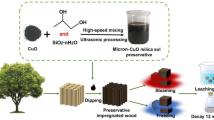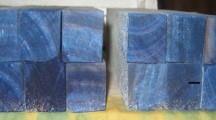Abstract
The aim of the research project was to determine the capability of the protein-borate preservative to penetrate into the wood of Scots pine (Pinus sylvestris L.) and aspen poplar (Populus tremula L.). This capability was assessed by the preservative retention and the measurement of the penetration depth of the treatment solution. The scope of the performed experiments comprised two methods of treatment. The treatability of the two wood species with the examined formulations was compared with their treatability with the solution of the boric acid alone or with protein. The performed quantitative analysis of the boric acid and protein in individual wood layers allowed to characterise the distribution of the formulation ingredients on the cross-section of the treated elements. Significant differences were shown to occur in the degree of wood treatment with the formulation containing globular protein using the vacuum and vacuum-pressure methods. In addition, the impact of the protein presence on the way of boric acid penetration into wood was also determined.
Zusammenfassung
Ziel dieses Forschungsprojekts war es, die Eindringfähigkeit von Holzschutzmitteln auf Proteinborat-Basis in Kiefern- (Pinus sylvestris L.) und Aspenholz (Populus tremula L.) zu bestimmen. Diese wurde anhand der Schutzmittelaufnahme und der Messung der Eindringtiefe der Imprägnierlösung bewertet. Zwei verschiedene Tränkverfahren wurden untersucht. Die Tränkbarkeit der beiden Holzarten mit den untersuchten Rezepturen wurde mit der von reiner Borsäure und reiner Proteinlösung verglichen. Anhand der durchgeführten quantitativen Analyse von Borsäure und Protein in den einzelnen Holzschichten konnte die Verteilung der Rezepturbestandteile im Querschnitt der behandelten Proben bestimmt werden. Mittels Vakuum- und Vakuum-Druck-Verfahren ergaben sich deutliche Unterschiede im Umfang der Imprägnierung mit der Rezeptur, die globuläres Protein enthält. Darüber hinaus wurde bestimmt, wie Protein die Eindringung von Borsäure in Holz beeinflusst.
Similar content being viewed by others
References
van Acker J, Stevens M, De Haas C (1990) Influence of clonal variability on the impregnability of poplar hybrids. IRG/WP 90-3614
van Acker J, Stevens M (1995) Investigation into the heterogeneous nature of the impregnability of some poplar hybrids. IRG/WP 95-40052
Lutomski K, Cofta G, Mazela B, Remi R (1997) Investigations on impregnation ability of European aspen (Populus tremula L.) wood. Folia For Pol B 28:73–84
Lutomski K (2002) Metody badañ chemicznych środków ochrony drewna i technologii ich stosowania. Akademia Rolnicza, Poznañ
Mazela B, Polus I, Bartkowiak M (2002) The preliminary investigation on the use of impregnating formulations with blood protein in the wood treatment – part I. Ochrona Drewna – Proceedings of the 21st Conf. in Rogów 2002, PAN, Komitet Technologii Drewna, SGGW Warszawa, pp 97–105
Mazela B, Polus I, Bartkowiak M (2002) The preliminary investigation on the use of impregnating formulations with blood protein in the wood treatment – part II. Ochrona Drewna – Proceedings of the 21st Conf. in Rogów 2002, PAN, Komitet Technologii Drewna, SGGW Warszawa, pp 105–113
Mazela B, Polus-Ratajczak I (2003) Use of Animal Proteins to Limit Leaching of Active Copper Ions Preservatives from Treated Wood. Holzforschung 57:593–596
Mazela B, Ratajczak I, Bartkowiak M (2005) Reduction of preservatives leaching from wood by the application of animal proteins. IRG/WP 05-30387
Murray RK, Granner DK, Mayes RA, Rodwell VW (1995) Biochemia Harpera. Wyd Lekarskie PZWL, Warszawa
Pizzi A (1993) A New Approach to Non-Toxic, Wide-Spectrum, Ground-Contact Wood Preservatives. Part I. Approach and Reaction Mechanisms. Holzforschung 47:253–260
Pizzi A (1993) A New Approach to Non-Toxic, Wide-Spectrum, Ground-Contact Wood Preservatives. Part II. Accelerated and Long-Term Field Tests. Holzforschung 47:343–348
Pizzi A, Baecker A (1996) A New Boron Fixation Mechanism for Environment Friendly Wood Preservatives. Holzforschung 50:507–510
Polus-Ratajczak I, Mazela B, Goliñski P (2003) The chemical interaction of animal origin proteins with cellulose and lignin in wood preservation. Ann Warsaw Agric Univ – SGGW, For Wood Technol 53:296–299
Siau JF (1984) Transport processes in wood. Springer-Verlag, Berlin Heidelberg New York Tokyo, p 50
Thevenon MF, Pizzi A, Haluk JP (1997) Non-toxic albumin and soja protein borates as ground-contact wood preservatives. Holz Roh- Werkst 55(5):293–296
Thevenon MF, Pizzi A, Haluk JP (1998a) One-step tannin fixation of non-toxic protein borates wood preservatives. Holz Roh- Werkst 56(1):90
Thevenon MF, Pizzi A, Haluk JP, Zaremski A (1998) Normalized biological testing of protein borates wood preservatives. Holz Roh- Werkst 56(3):162
Thevenon MF, Pizzi A (2003) Polyborate ions’ influence on the durability of wood treated with non-toxic protein borate preservatives. Holz Roh- Werkst 61:457–464
Author information
Authors and Affiliations
Corresponding author
Rights and permissions
About this article
Cite this article
Mazela, B., Domagalski, P., Mamonova, M. et al. Protein impact on the capability of the protein-borate preservative penetration and distribution into pine and aspen wood . Holz Roh Werkst 65, 137–144 (2007). https://doi.org/10.1007/s00107-006-0147-3
Published:
Issue Date:
DOI: https://doi.org/10.1007/s00107-006-0147-3




